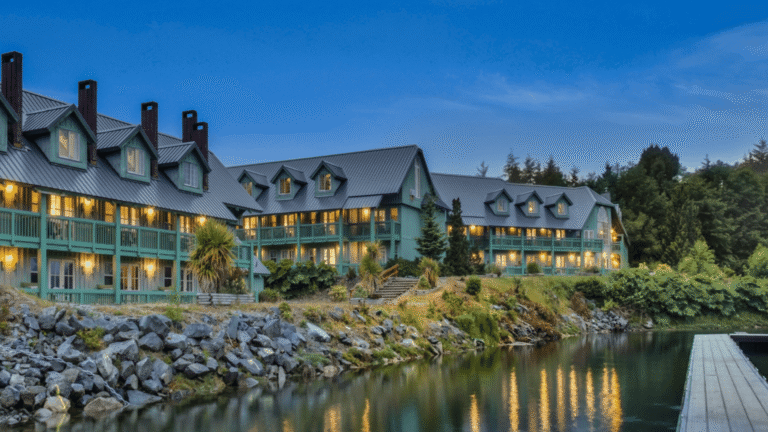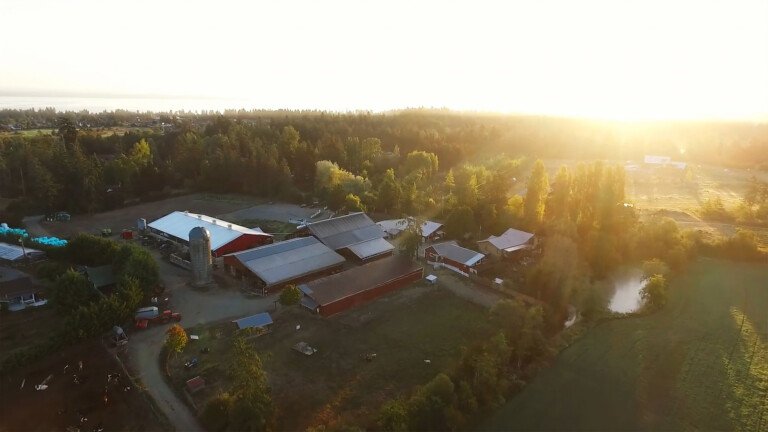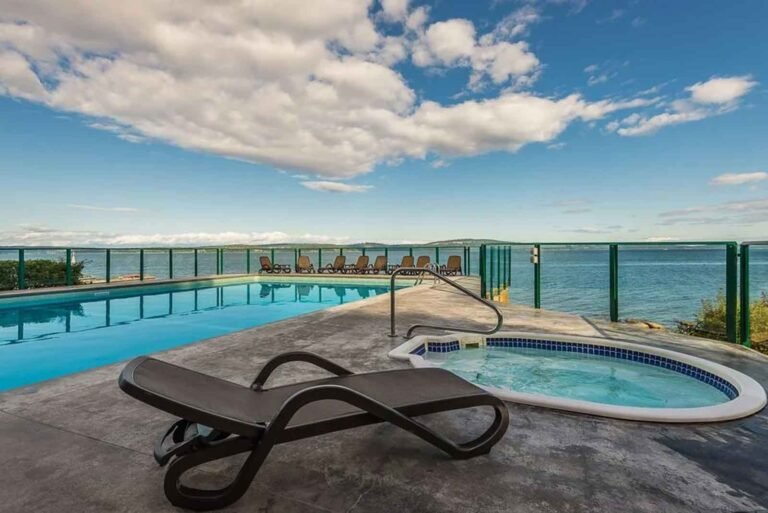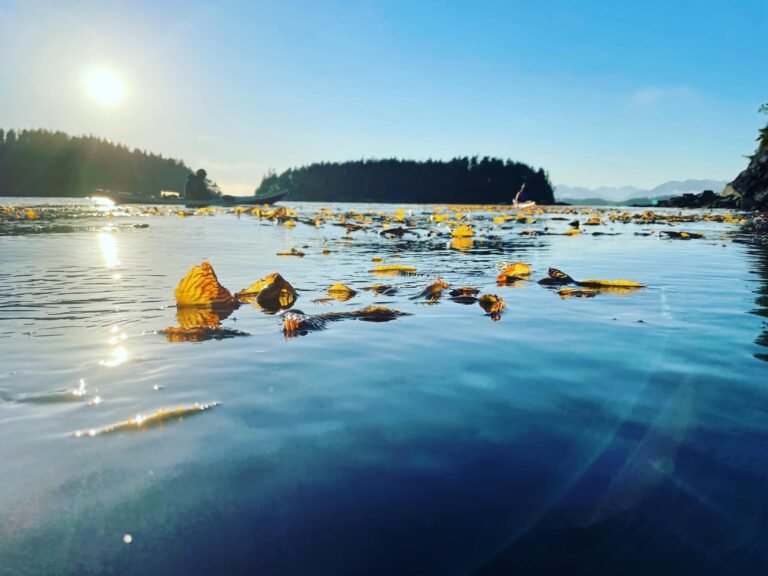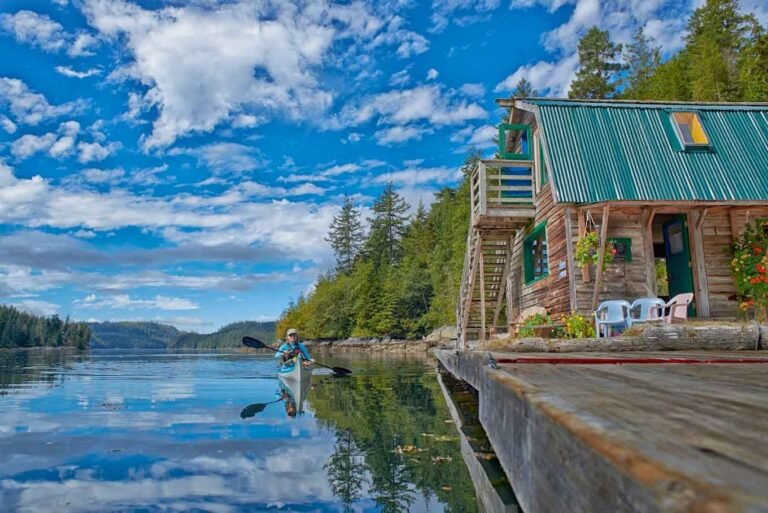Located on the Fraser River in the scenic Robson Valley, only 11 km (7 miles) west of Mount Robson, Tete Jaune Cache is at the confluence of the Fraser and Robson Rivers, and marks the intersection of the Yellowhead Highway 5 and Yellowhead Highway 16.
The valley is surrounded by three mountain ranges; the Monashee, the Premier and the Rocky Mountains, and cradles the historical Tete Jaune Cache, a growing town of about 1,500 people on the site of the original Tete Jaune Cache village.
The old village is gone now, and only a few ruins remain of the once thriving community of 3,000 people. This was the nerve centre during the construction of the Grand Trunk Railway in the early 1900s. It was the final destination for the flat bottom stern wheelers that travelled the Fraser River bringing equipment and supplies to the railway camps.
Tete Jaune Cache, the Yellowhead Highway and Yellowhead Pass were named after a fur trader and trapper that guided for the Hudson’s Bay Company in the early 1800s. The yellow-haired Iroquois Metis guide Pierre Hastination (also recorded as Pierre Bostonais), was named Tete Jaune by the French voyageurs because of his blonde-streaked hair (Tete Jaune means yellow head in French). Tete Jaune lead an HBC group across the Rocky Mountains in December 1819, to meet and befriend the Shuswap Indians. Since the time Tete Jaune had guided for the Hudson’s Bay Company, he had been hunting and trapping in the area between the Smoky River Post, Jasper and Fort George, and had established a fur cache on the Grand Fork of the Fraser, somewhere in the vicinity of the present day viewpoint.
In 1825 the Hudson’s Bay Company sent a group guided by Tete Jaune to survey the Yellowhead Pass area. The Yellowhead Pass (elevation 3,730 feet/1138 m), is 48 miles (77 km) east of Tete Jaune Cache on the British Columbia-Alberta border, and marks the border between Mount Robson Provincial Park and Jasper National Park. The pass was once known as Leather Pass because of the large quantities of moose hides transported through the pass.
Tete Jaune continued trapping and trading in the area and by 1827 had relocated his cache from the Grand Fork of the Fraser to the vicinity of the Shuswap salmon fishing camp on the Fraser River where the town of Tete Jaune Cache stands today. The relocation was made to facilitate trading with Fort George. Unfortunately, Tete Jaune was not allowed to continue trapping. Sometime in 1828, near the headwaters of the Smoky River, Tete Jaune, his brother, their wives and children were murdered by the Beaver Indians for revenge on the Iroquois for their earlier encroachment into the Beaver’s hunting territory.
By the 1830s, the Yellowhead Highway was truly being used as a “trans-Canada highway”. Red River carts rolled along it in 1841, miners used it for the Caribou Gold Rush in 1856, the 1862 Overlanders followed it to Kamloops and Prince George, and settlers followed it to their new homesteads in the West.
Driving the Yellowhead through this area affords spectacular views of the Rocky Mountains to the east and the Cariboo Mountains to the west, with many long stretches between towns as the road cuts through gorges and thickly forested bear country. There is an abundance of wildlife in the area, including black bear, deer, elk, and eagles. Travelling from Kamloops in the south, the Yellowhead Highway 5 climbs gradually through rolling hills, following the North Thompson River north through Clearwater, Blue River and on to Valemount. There are four major mountain passes, Yellowhead (1,146 m), Sunwapta (2,035 m), Kicking Horse (1,647 m) and Rogers Pass (1,330 m), in addition to the climb to Bow Summit, the highest point along the route at 2,068 metres. At Tete Jaune Cache travellers can turn east to cross the Rocky Mountains and head to Jasper, Alberta, just over an hour away.
Population: 500
Location: Tete Jaune Cache is located at the junction of the Yellowhead Highway 5 and Highway 16, 211 miles (338 km) north of Kamloops. To the south is Valemount (11 miles/18 km), and to the north on Highway 16 is the community of McBride.
Farmer’s Market at the Dunster Hall is an old-fashioned flea market and farmer’s market, complete with fresh farm produce and home baking. The market operates most Saturday mornings during July and August, and is the place to be on Saturdays in the Robson Valley.
Helicopter Sightseeing Tours offer a unique opportunity to see the valley from the air. Take a panoramic aerial tour of magnificent Mount Robson and Mount Terry Fox, or fly over glaciers with their yawning crevasses of ancient ice.
You can fish at Rearguard Falls Provincial Park, approximately 5 km east of Tete Jaune Cache on Hwy 16. The park is on the Upper Fraser River, and the falls are the final barrier to salmon migrating from the Fraser’s mouth, some 744 miles (1,200 km) southeast at the Pacific Ocean. Salmon season begins in August and continues through September.
Fishing: Guided fishing trips are available, and fly-in fishing lodges are located on some of the 700 lakes in the area – flights depart and return to Kamloops Airport.
Kinbasket Lake: To canoe the long and skinny Kinbasket Lake, start at Canoe Reach, near the north end of the lake, just south of Tete Jaune Cache on Hwy 5, and work your way south. There’s a boat launch beside Hwy 16 in Mount Robson Provincial Park that provides access to Moose Lake and Yellowhead Lake in the park. Kinbasket Lake also offers superb fishing for trout, kokanee and dolly varden.
Whitewater Rafting: One of the most exhilarating outdoor activities has got to be whitewater rafting, and you shouldn’t miss the opportunity to indulge in it while you’re in this region chock full of rivers. The Fraser River whitewater rafting trip offers class 3+ rapids.
If whitewater is too much for you, you can embark on a gentle raft trip down the upper Fraser River, enjoying fabulous mountain scenery from the safety of a large escorted river raft. No paddling required. If this is too slow for you, try a jetboat tour instead.
Horseback Riding: The mountainous area around Tete Jaune Cache is a perfect place for guided horseback riding trips to happen. See the Robson Valley from high upon a ridge, on the back of a well trained horse – suitable for riders of all ages and levels of experience.
Outdoor Adventure: The surrounding mountains offer numerous mountain bike trails, guided hiking opportunities as well as heli-hiking – guided alpine hiking around Mt Robson.
Offroading: You know you can reach the mountain ridges surrounding the Robson Valley by horseback, hiking, snowmobile or by helicopter. No prize so far, but have you considered a backcountry adventure by ATV? Tour alone or with friends, an exciting challenge for all. Some of the guided expeditions take you to over 3,000 metres above sea level, to summits that reveal many breathtaking panoramas. Let guides show you the true backcountry and alpine meadows, pass creeks, see old original trapper cabins and stop for breathtaking views over different valleys.
Camping: South of Tete Jaune Cache, Valemount has a good municipal campground beside Swift Creek.
Winter Activities: Valemount is the hub of the Cariboo, Monashee, and Rocky Mountains, and is the best base you can have for your heli-skiing and snowmobiling adventure. These mountains provide an ideal variety of snowmobiling terrain, including scenic logging roads, high plateaus, and steep mountain trails. Riding through deep powder snow above the tree line with a view forever is a thrill beyond compare. Clemina Creek, Allen Creek and Miledge Creek all have marked and groomed trails, with day cabins on or near the alpine at Clemina Creek and Allen Creek. Snowmobile tours are available.
Dog Sledding: Enjoy the crisp mountain air in winter while you explore the beautiful mountain scenery guiding your own dogsled team! Learn the history of the scenic area and learn about dog sledding as the friendly husky team quietly pulls your sled along.
At Jackman Flats, 3 miles (5 km) south of Tete Jaune Cache, visitors will find unique botanical interpretive trails. And August and September is the time to witness the always-amazing spectacle of the Fraser River salmon run in Rearguard Falls. The McLennan River salmon spawning area is an essential stop during salmon spawning season – from mid August to mid September.
Golf: Golfers must head south to Valemount to tee off at the Valemount Pine Golf & Country Club, a 9-hole semi-private golf course situated on a plateau with wonderful mountain views, or the Melsview Links Golf Club, a public 9-hole course located 1km South of Valemount on Highway 5. Golf Vacations in British Columbia.
Ten minutes north of Tete Jaune Cache is the Spittal Creek Interpretive Forest with two self-guiding interpretive trails exploring different forest environments and tree species. Both well-marked trails have gentle grades and take between 30 and 60 minutes to complete.
The Lookout Trail at Kiwa Creek northwest of Tete Jaune Cache leads to a forestry lookout tower atop Shere Point. The 90-minute hike to the tower rewards with a stunning view of the Robson Valley and the villages of McBride and Valemount. The scenic Lookout on Watertank Hill provides another great view of the Valley.
A challenging 13-km round-trip hike in Mount Terry Fox Provincial Park leads into the alpine zone from its trailhead north of Valemount. Staggeringly impressive views are everywhere along this route. Mount Terry Fox is located just south of Tete Jaune Cache off Hwy 5.
Mount Robson: The peak of Mount Robson is the highest in the Canadian Rockies, towering 12,972 feet (3954 m) over the western entrance to the park. Mount Robson Provincial Park, one of the oldest in British Columbia, contains the headwaters of the Fraser River, and, in the northwest section of the park, the massive Berg Glacier, notable for being one of the few living (or advancing) glaciers in the Canadian Rockies. To really experience Mount Robson Provincial Park you need to get out of your vehicle and hike, as the superb scenery in the park makes it an excellent site for hikers, climbers, and backcountry enthusiasts.
The park contains 202 km of hiking trails ranging from easy strolls to challenging backcountry excursions. Rearguard Falls and Overlander Falls are short walks, while the Mount Fitzwilliam Trail and the spectacular Berg Lake Trail, which starts in a Cedar Rain Forest and meanders through the Valley of a Thousand Falls, offer wilderness camping opportunities.
There are three camping areas in the park: Robson Meadows Campground and Robson River Campground, both near the western boundary, and Lucerne Campground, just west of the Alberta border. Wilderness campsites are also located along the Berg Lake Trail. Concrete boat launches and ample parking are located at the east end of Moose Lake and at Yellowhead Lake; the latter also has a sandy beach. Take Hwy 16 east from its junction with Hwy 5 in Tete Jaune Cache into the park.
Wells Gray Provincial Park is one of BC’s largest and most spectacular parks. Its area encompasses the greater part of the Clearwater River watershed. There are five major lakes here, as well as two large river systems, numerous small lakes, streams, and waterways, and a multitude of waterfalls, rapids, and cataracts. Although boating and paddling are major attractions for campers, the park is laced with hiking trails, and has something for everyone. In winter, there are just as many opportunities for recreation as in summer, with the advantage of no bugs! This park is as ideal as any you will find in the province, with a climate and terrain varied enough to suit the most demanding backpacker or mountaineer. Vehicle access to the park is at Blue River, south of Tete Jaune off Highway 5, and farther south at Clearwater.
Travel the Dunster-Croydon Road that winds through the Fraser River headlands, passing through lush forests and sleepy rangelands bordered by magnificent snow-capped mountains to the farming community of Dunster. Hill’s General Store has just about everything you need, and across the street is the historic Dunster Train Station, one of the last of the original train stations built by the Canadian National Railways in the early 1900s.
Just 15 minutes east of Dunster is the village of South Croydon, once a thriving rail building community, and now the home to just one family. They run the Bear’s Lair Studio and Gallery where they create fine handcrafted fabric arts, paintings, drawings and photographs. The studio is housed in a heritage building that began as a mill office and later became the post office. You will also find a wildlife holding facility, where injured or orphaned animals live until returned to the wild. Mountain Pottery is found at the foot of the Old South Croydon Ferry Road and features hand thrown pottery and watercolours.
How to get to Tete Jaune Cache:
Nearest International Airports: Vancouver, Calgary and Edmonton
Nearest Regional Airports: Prince George and Kamloops
Nearest Community Airport: Valemount and McBride
Greyhound Bus Station: Tete Jaune Cache, Valemount, Dunster or McBride.
Distance Jasper to Tete Jaune Cache: 101 km
Distance Tete Jaune Cache to Prince George: 241 km
Distance Tete Jaune Cache to Kamloops: 332 km
Willmore Wilderness Park in the Rocky Mountains of central Alberta is a beautiful untouched wilderness area with pristine forests and stunning panoramic mountain vistas. Willmore offers wonderful outdoor activities, including hiking, mountain biking, multi-day horseback riding trips, horse assisted hiking excursions, and great fishing opportunities. Willmore Wilderness Park can be accessed from McBride and points along Highway 16 in BC.
Circle Tours: See the best of the area on Okanagan and Kootenay Rockies Circle Tour. Travel the sunny interior of British Columbia, north through the Okanagan to Sicamous, following Highway 1 into the mountains of the BC Rockies. From Golden, head south through the Columbia Valley to Creston, and west through the Southern Okanagan, starting and ending your sun-drenched voyage in Osoyoos, the place where two lakes come together. Circle Tours in British Columbia.


